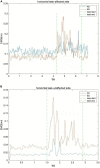Upper Limbs Muscle Co-contraction Changes Correlated With the Impairment of the Corticospinal Tract in Stroke Survivors: Preliminary Evidence From Electromyography and Motor-Evoked Potential
- PMID: 35720692
- PMCID: PMC9198335
- DOI: 10.3389/fnins.2022.886909
Upper Limbs Muscle Co-contraction Changes Correlated With the Impairment of the Corticospinal Tract in Stroke Survivors: Preliminary Evidence From Electromyography and Motor-Evoked Potential
Abstract
Objective: Increased muscle co-contraction of the agonist and antagonist muscles during voluntary movement is commonly observed in the upper limbs of stroke survivors. Much remain to be understood about the underlying mechanism. The aim of the study is to investigate the correlation between increased muscle co-contraction and the function of the corticospinal tract (CST).
Methods: Nine stroke survivors and nine age-matched healthy individuals were recruited. All the participants were instructed to perform isometric maximal voluntary contraction (MVC) and horizontal task which consist of sponge grasp, horizontal transportation, and sponge release. We recorded electromyography (EMG) activities from four muscle groups during the MVC test and horizontal task in the upper limbs of stroke survivors. The muscle groups consist of extensor digitorum (ED), flexor digitorum (FD), triceps brachii (TRI), and biceps brachii (BIC). The root mean square (RMS) of EMG was applied to assess the muscle activation during horizontal task. We adopted a co-contraction index (CI) to evaluate the degree of muscle co-contraction. CST function was evaluated by the motor-evoked potential (MEP) parameters, including resting motor threshold, amplitude, latency, and central motor conduction time. We employed correlation analysis to probe the association between CI and MEP parameters.
Results: The RMS, CI, and MEP parameters on the affected side showed significant difference compared with the unaffected side of stroke survivors and the healthy group. The result of correlation analysis showed that CI was significantly correlated with MEP parameters in stroke survivors.
Conclusion: There existed increased muscle co-contraction and impairment in CST functionality on the affected side of stroke survivors. The increased muscle co-contraction was correlated with the impairment of the CST. Intervention that could improve the excitability of the CST may contribute to the recovery of muscle discoordination in the upper limbs of stroke survivors.
Keywords: correlation analyses; corticospinal tract; motor-evoked potential; muscle co-contraction; stroke.
Copyright © 2022 Sheng, Li, Zhao, Wang, Luo, Lo, Ding, Wang and Li.
Conflict of interest statement
The authors declare that the research was conducted in the absence of any commercial or financial relationships that could be construed as a potential conflict of interest.
Figures





Similar articles
-
Home-based self-help telerehabilitation of the upper limb assisted by an electromyography-driven wrist/hand exoneuromusculoskeleton after stroke.J Neuroeng Rehabil. 2021 Sep 15;18(1):137. doi: 10.1186/s12984-021-00930-3. J Neuroeng Rehabil. 2021. PMID: 34526058 Free PMC article.
-
Altered Corticomuscular Coherence (CMCoh) Pattern in the Upper Limb During Finger Movements After Stroke.Front Neurol. 2020 May 14;11:410. doi: 10.3389/fneur.2020.00410. eCollection 2020. Front Neurol. 2020. PMID: 32477257 Free PMC article.
-
Hysteresis in corticospinal excitability during gradual muscle contraction and relaxation in humans.Exp Brain Res. 2003 Sep;152(1):123-32. doi: 10.1007/s00221-003-1518-1. Epub 2003 Jul 17. Exp Brain Res. 2003. PMID: 12879181
-
Pathway-specific cortico-muscular coherence in proximal-to-distal compensation during fine motor control of finger extension after stroke.J Neural Eng. 2021 Sep 21;18(5). doi: 10.1088/1741-2552/ac20bc. J Neural Eng. 2021. PMID: 34428752
-
Power spectral analysis of surface electromyography (EMG) at matched contraction levels of the first dorsal interosseous muscle in stroke survivors.Clin Neurophysiol. 2014 May;125(5):988-94. doi: 10.1016/j.clinph.2013.09.044. Epub 2013 Nov 21. Clin Neurophysiol. 2014. PMID: 24268816 Clinical Trial.
Cited by
-
Effect of bihemispheric transcranial direct current stimulation on distal upper limb function and corticospinal tract excitability in a patient with subacute stroke: a case study.Front Rehabil Sci. 2023 Sep 5;4:1250579. doi: 10.3389/fresc.2023.1250579. eCollection 2023. Front Rehabil Sci. 2023. PMID: 37732289 Free PMC article.
-
Effects of EMG-based robot for upper extremity rehabilitation on post-stroke patients: a systematic review and meta-analysis.Front Physiol. 2023 May 3;14:1172958. doi: 10.3389/fphys.2023.1172958. eCollection 2023. Front Physiol. 2023. PMID: 37256069 Free PMC article.
-
Primary motor hand area corticospinal excitability indicates overall functional recovery after spinal cord injury.Front Neurol. 2023 Jun 2;14:1175078. doi: 10.3389/fneur.2023.1175078. eCollection 2023. Front Neurol. 2023. PMID: 37333013 Free PMC article.
-
Myogenic and cortical evoked potentials vary as a function of stimulus pulse geometry delivered in the subthalamic nucleus of Parkinson's disease patients.Front Neurol. 2023 Aug 24;14:1216916. doi: 10.3389/fneur.2023.1216916. eCollection 2023. Front Neurol. 2023. PMID: 37693765 Free PMC article.
-
Alterations in the preferred direction of individual arm muscle activation after stroke.Front Neurol. 2023 Sep 22;14:1280276. doi: 10.3389/fneur.2023.1280276. eCollection 2023. Front Neurol. 2023. PMID: 37808491 Free PMC article.
References
LinkOut - more resources
Full Text Sources

